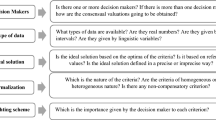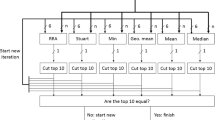Abstract
In this work, a TOPSIS-based approach is proposed based on the idea of ideal similarity. It considers the ideal solution not necessarily related to the optimum values of the decision criteria, but to any values between the minimum and maximum values of the criteria ranges. The proposed method allows the consideration of one or several decision makers; different types of data (single numerical values, intervals or linguistic variables); different normalization functions describing the importance given by the decision makers to the deviation of alternatives from the ideal solution and different weighting schemes. The procedure also allows the decision maker to decide how much information about the intervals he is willing to take into account (e.g. the expected value, the extremes of the interval or the entire set of values in the intervals). In order to illustrate the practical applicability of the approach we include a real example consisting of the ranking of mathematical educational videos based on six didactical dimensions. The rating of educational videos is of great interest for educators due to their high popularity in Internet, especially in platforms as You Tube which has become one of the most used sources of information nowadays.




Similar content being viewed by others
References
Arroyo-Cañada FJ, Gil-Lafuente J (2017) A fuzzy asymmetric TOPSIS model for optimizing investment in online advertising campaigns. Oper Res. https://doi.org/10.1007/s12351-017-0368-8
Azer SA, AlGrain HA, AlKhelaif RA, AlEshaiwi SM (2013) Evaluation of the educational value of YouTube videos about physical examination of the cardiovascular and respiratory systems. J Med Internet Res 15(11):e241
Behzadian M, Otaghsara SK, Yazdani M, Ignatius J (2012) A state-of the-art survey of TOPSIS applications. Expert Syst Appl 39(7):13051–13069
Bilbao-Terol A, Arenas-Parra M, Onopko-Onopko V (2017) Measuring regional sustainable competitiveness: a multi-criteria approach. Oper Res. https://doi.org/10.1007/s12351-017-0367-9
Brans JP, Vincke P, Mareschal B (1986) How to select and how to rank projects the PROMETHEE method. Eur J Oper Res 24:228–238
Cables E, Lamata MT, Verdegay JL (2016) RIM-reference ideal method in multicriteria decision making. Inf Sci 337–338:1–10
Canós L, Casasús T, Liern V, Pérez JC (2014) Soft computing methods for personnel selection based on the valuation of competences. Int J Intell Syst 29:1079–1099
Çelen A (2014) Comparative analysis of normalization procedures in TOPSIS method with an application to Turkish deposit banking market. Informatica 25(2):185–208
Chakraborty S, Yeh CH (2009) A simulation comparison of normalization procedures for TOPSIS. In: Proceeding of computers industrial engineering international conference CIE 2009, pp 1815–1820
Chang CH, Lin JJ, Lin JH, Chiang MC (2010) Domestic open-end equity mutual fund performance evaluation using extended TOPSIS method with different distance approaches. Expert Syst Appl 37:4642–4649
Chen SJ, Hwang CL (1992) Fuzzy multiple attribute decision making methods and applications, vol 375. Springer, Berlin
Churchman CW, Ackoff RL (1954) An approximate measure of value. J Oper Res Soc Am 2(2):172–187
Dubois D, Prade H (1978) Fuzzy sets and systems theory and applications. Mathematics in science and engineering, vol 14. Academic Press, London
Dymova L, Sevastjanov P, Tikhonenko A (2013) An approach to generalization of fuzzy TOPSIS method. Inf Sci 238:149–162
Gendall P, Hoek J (1990) A question of wording. Mark Bull 5:25–36
Godino JD, Wilhelmi MR, Bencomo D (2005) Suitability criteria of a mathematical instruction process. A teaching experience of the function notion. Mediterr J Res Math Educ 4(2):1–26
Godino JD, Batanero C, Font V (2007) The onto-semiotic approach to research in mathematics education. Int J Math Educ 39(1–2):127–135
Gomes LFAM, Lima MMPP (1992) TODIM basics and application to multicriteria ranking of projects with environmental impacts. Found Comput Decis Sci 16(4):113–127
Heilpern S (1992) The expected value of a fuzzy number. Fuzzy Sets and Systems 47(1):81–86. https://doi.org/10.1016/0165-0114(92)90062-9
Hwang CL, Yoon K (1981) Multiple attribute decision making methods and applications a State of the Art Survey. Springer, Berlin
Kaufmann A, Gupta MM (1988) Fuzzy mathematical models in engineering and management science. North-Holland, Amsterdam
Khademi-Zare H, Zarei M, Sadeghieh A, Saleh Owlia M (2010) Ranking the strategic actions of Iran mobile cellular telecommunication using two models of fuzzy QFD. Telecommun Policy 34:747–759
Milani AS, Shanian R, Madoliat R, Nemes JA (2005) The effect of normalization norms in multiple attribute decision making models a case study in gear material selection. Struct Multidiscipl Optim 29(4):312–318
Opricovic S (1998) Multicriteria optimization of civil engineering systems, Faculty of Civil Engineering, Belgrade
Opricovic S, Tzeng GH (2004) The Compromise solution by MCDM methods: a comparative analysis of VIKOR and TOPSIS. Eur J Oper Res 156(2):445–455
Pavlicic D (2001) Normalization affects the results of MADM methods. Yugosl J Oper Res 11(2):251–265
Pino-Fan L, Assis A, Castro WF (2015) Towards a methodology for the characterization of teachers’ didactic-mathematical knowledge. Eurasia J Math Sci Technol Educ 11(6):1429–1456
Roy B (1968) Classement et choix en présence de points de vue multiples La méthode ELECTRE. Rev Franfaise Inform Rech Oper 6(8):57–75
Roy B (1985) Méthodologie Multicritère d’aide à la Décision. Economica, Paris
Santos-Mellado JA, Acuña-Soto CM, Blasco-Blasco O, Liern V (2017) Use of maths video tutorials. What are the users looking for? In: Proceedings 9th annual international conference on education and new learning technologies, pp 8536–8541
Tan C (2011) A multi-criteria interval-valued intuitionistic fuzzy group decision making with Choquet integral-based TOPSIS. Expert Syst Appl 38:3023–3033
Thomaidis F, Konidari P, Mavrakis D (2008) The wholesale natural gas market prospects in the Energy Community Treaty countries. Oper Res 8(1):63–75
Triantaphyllou E (2000) Multi-criteria decision making: a comparative study. Kluwer, Dordrecht
Vega A, Aguarón J, García-Alcaraz J, Moreno-Jiménez JM (2014) Notes on dependent attributes in TOPSIS. Proc Comput Sci 31:308–317
Wang YJ (2014) A fuzzy multi-criteria decision-making model by associating technique for order preference by similarity to ideal solution with relative preference relation. Inf Sci 268:169–184
Yang Q, Du P, Wang Y, Liang B (2017) Developing a rough set based approach for group decision making based on determining weights of decision makers with interval numbers. Oper Res. https://doi.org/10.1007/s12351-017-0344-3
Yoon KP, Hwang CL (1995) Multiple attribute decision making: an introduction. Sage, London
Zanakis SH, Solomon A, Wishart N, Dublish S (1998) Multi-attribute decision making: a simulation comparison of select methods. Eur J Oper Res 107(3):507–529
Zavadskas EK, Peldschus F, Ustinovichius L (2003) Development of software for multiple criteria evaluation. Informatica 14(2):259–272
Zavadskas EK, Zakarevicius A, Antucheviciene J (2006) Evaluation of ranking accuracy in multi-criteria decisions. Informatica 17(4):601–617
Zeng W, Guo P (2008) Normalized distance, similarity measure, inclusion measure and entropy of interval-valued fuzzy sets and their relationship. Inf Sci 178:1334–1342
Zimmermann HJ (1996) Fuzzy set theory. Kluwer, Boston
Zyoud SH, Fuchs-Hanusch D (2017) A bibliometric-based survey on AHP and TOPSIS techniques. Expert Syst Appl 78:158–181
Author information
Authors and Affiliations
Corresponding author
Rights and permissions
About this article
Cite this article
Acuña-Soto, C.M., Liern, V. & Pérez-Gladish, B. Multiple criteria performance evaluation of YouTube mathematical educational videos by IS-TOPSIS. Oper Res Int J 20, 2017–2039 (2020). https://doi.org/10.1007/s12351-018-0405-2
Received:
Revised:
Accepted:
Published:
Issue Date:
DOI: https://doi.org/10.1007/s12351-018-0405-2




